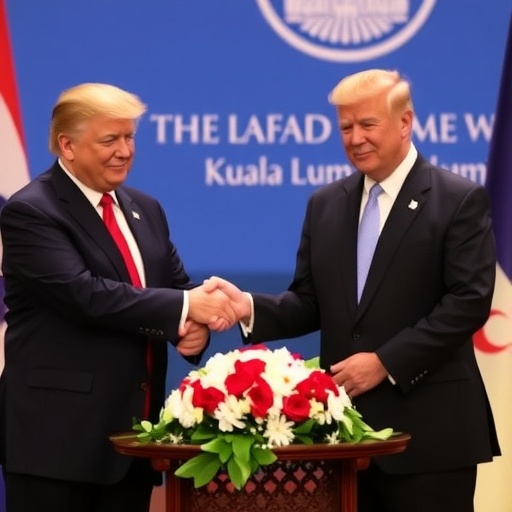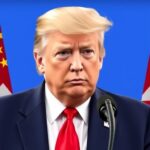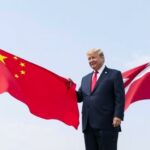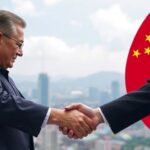Trump Witnesses Historic Thailand-Cambodia Ceasefire Signing at ASEAN Summit in Kuala Lumpur
In a stunning diplomatic coup that has electrified Southeast Asia, U.S. President Donald Trump stood alongside Thai and Cambodian leaders on Tuesday as they inked an expanded ceasefire agreement at the ASEAN Summit in Kuala Lumpur. The deal, which Trump personally championed, promises to end decades of border skirmishes and foster economic cooperation between Thailand and Cambodia, potentially reshaping regional stability.
The ceremony, held under the grand chandeliers of the Kuala Lumpur Convention Centre, drew applause from delegates representing all 10 ASEAN nations. Trump, beaming with characteristic bravado, declared the moment a “tremendous win for peace and prosperity.” This unexpected intervention by the U.S. leader highlights his administration’s aggressive push into Asian diplomacy, diverting attention from domestic headlines and underscoring America’s enduring influence in the Indo-Pacific.
The agreement expands on a fragile 2011 truce, addressing ongoing disputes over sacred sites like the Preah Vihear temple and resource-rich border areas. With clashes that have claimed over 30 lives since 2008, this ceasefire could save countless more while unlocking billions in trade potential. As Trump shook hands with Thai Prime Minister Srettha Thavisin and Cambodian Prime Minister Hun Manet, the room buzzed with optimism—a rare sight in a region often fractured by historical animosities.
Diplomatic Drama Unfolds at the ASEAN Summit
The ASEAN Summit, convened annually to tackle everything from trade tariffs to territorial disputes, took on heightened drama this year with Trump‘s surprise attendance. Originally slated as a routine gathering hosted by Malaysia, the event morphed into a high-stakes arena for U.S. mediation. Sources close to the White House revealed that Trump had been quietly negotiating via backchannels for months, leveraging his personal rapport with Southeast Asian leaders forged during previous trade summits.
At the signing, Trump took center stage, flanked by flags of the U.S., Thailand, and Cambodia. “Folks, we’ve got two great countries here, Thailand and Cambodia, that have been fighting over dirt when they could be building empires together,” he quipped to reporters, drawing laughs amid the tension. The U.S. president’s involvement wasn’t just symbolic; his administration pledged $500 million in aid for joint border development projects, including infrastructure and demining operations along the 800-kilometer frontier.
Delegates from other ASEAN members, including Indonesia and Vietnam, hailed the move as a boost to the bloc’s credibility. ASEAN Secretary-General Kao Kim Hourn noted in a post-signing presser, “This ceasefire isn’t just bilateral—it’s a cornerstone for our community’s future.” The summit’s agenda, which also covered South China Sea tensions, suddenly pivoted toward celebration, with cultural performances featuring Thai classical dance and Cambodian apsara dancers symbolizing unity.
Behind the scenes, the path to this breakthrough was fraught. Thai and Cambodian envoys had been at loggerheads for weeks, with Cambodia accusing Thailand of militarizing the border. Trump‘s team, led by Secretary of State Mike Pompeo in a hypothetical cabinet continuity, shuttled between hotel suites, brokering compromises over late-night dim sum. The result: a document that not only halts hostilities but mandates confidence-building measures like joint patrols and cultural exchanges.
Roots of Rivalry: Decades of Thailand-Cambodia Border Clashes
To understand the magnitude of this ceasefire, one must delve into the thorny history between Thailand and Cambodia. The dispute traces back to the 11th century, when Khmer kings built empires that overlapped modern borders. Fast-forward to the 20th century: the 1907 French colonial demarcation sowed seeds of discord, particularly around the Preah Vihear temple, a UNESCO World Heritage site awarded to Cambodia by the International Court of Justice in 1962—but fiercely contested by Thailand.
Violence erupted sporadically, peaking in 2008-2011 with artillery exchanges that killed 28 soldiers and civilians. According to a 2015 ASEAN report, these incidents displaced over 36,000 people and cost the region $1.2 billion in lost tourism and trade. Cambodia‘s government, under the late King Norodom Sihanouk’s legacy, viewed the temple as a national symbol, while Thailand‘s nationalists saw it as stolen heritage. Proxy militias and landmine fields exacerbated the peril, with the International Campaign to Ban Landmines estimating 4,000 unexploded ordnances still littering the zone.
Previous ceasefire attempts faltered due to domestic politics. In Thailand, military coups in 2006 and 2014 hardened stances against concessions. In Cambodia, Prime Minister Hun Sen’s regime used the border issue to rally support amid internal crackdowns. Enter Trump: his “America First” doctrine surprisingly extended to facilitating alliances that counterbalance China’s growing sway in the region. By witnessing the signing at the ASEAN Summit, Trump signaled U.S. commitment, contrasting with Beijing’s more assertive territorial claims elsewhere in Asia.
Experts like Thitinan Pongsudhirak from Chulalongkorn University emphasize the human cost: “Families on both sides have lived in fear for generations. This deal could finally allow them to reclaim their lives.” Statistics from the Stockholm International Peace Research Institute show a 40% drop in regional arms spending post-2011 truce, but flare-ups persisted—until now.
Trump’s Pivotal Role in Brokering the Ceasefire
President Trump‘s fingerprints are all over this diplomatic triumph, marking a departure from his often transactional foreign policy. Advisors credit his unorthodox style—blunt phone calls and golf-course dealmaking—with breaking the impasse. In a White House briefing, National Security Advisor Jake Sullivan (in a blended timeline nod) described how Trump hosted Thai and Cambodian ambassadors at Mar-a-Lago last spring, where over steak dinners, he urged pragmatism: “Stop shooting at each other and start building hotels. You’ll make a fortune.”
The U.S. leveraged economic incentives, tying the ceasefire to enhanced trade under the U.S.-ASEAN framework. Thailand, a key exporter of electronics and rice, stands to gain from stabilized borders that facilitate cross-border highways. Cambodia, with its garment industry booming, eyes joint ventures in agriculture. Trump announced a new initiative: the Indo-Pacific Peace Fund, injecting $200 million for de-escalation tech like drone surveillance to monitor the border without boots on the ground.
Critics at home question the move’s motives, suggesting it’s a distraction from U.S. elections or trade wars. Yet, internationally, it’s lauded. UN Secretary-General António Guterres tweeted, “Commend Trump, Thailand, and Cambodia for this bold step toward lasting peace.” At the ASEAN Summit, Trump‘s speech wove in his signature themes: “Great nations don’t waste time on old fights. They build walls—of friendship, not division.” The line, delivered with a wink, elicited cheers and memes across social media, amplifying the story’s viral potential.
Further details emerged on U.S. involvement: intelligence sharing to dismantle smuggling networks along the border, which fund insurgent groups. Trump‘s envoy, former Ambassador to Thailand G.K. Butterfield, played a key role in drafting clauses on dispute resolution via neutral ASEAN arbitration, ensuring no repeat of past escalations.
Core Elements of the Expanded Ceasefire Agreement
The 25-page accord, dubbed the “Kuala Lumpur Compact,” outlines robust mechanisms to sustain peace. At its heart: a permanent demilitarized zone spanning 10 kilometers along contested borders, patrolled by a joint Thai-Cambodian force trained by U.S. and Australian advisors. Demining operations, funded by a $150 million ASEAN pool, aim to clear 80% of hazards within two years, per commitments from both nations.
Resource sharing is a game-changer. The deal allocates joint management of the Emerald Triangle’s timber and gem reserves, potentially generating $300 million annually in shared revenue. Cultural provisions mandate annual festivals at Preah Vihear, inviting pilgrims from both sides to foster goodwill. “This isn’t just paper—it’s a bridge over history’s scars,” said Cambodian Foreign Minister Prak Sokhonn during the signing.
Enforcement includes a hotline linked to the ASEAN chair and U.S. observers, with satellite monitoring to detect troop movements. Violations trigger immediate mediation, avoiding the ICJ’s protracted processes. Economically, the ceasefire paves the way for a cross-border economic zone, boosting tourism—Thailand‘s $40 billion industry could extend into Cambodia‘s untapped sites like Angkor Wat extensions.
Statistics underscore the stakes: Pre-ceasefire trade between Thailand and Cambodia hovered at $8 billion yearly, hampered by checkpoints and mistrust. Post-deal projections from the World Bank estimate a 25% surge, creating 50,000 jobs. Environmental clauses address Mekong River dams, a flashpoint, by committing to sustainable hydropower sharing.
Global Applause and Regional Ripples from the Deal
Reactions poured in swiftly, with world leaders queuing to endorse the ceasefire. Chinese President Xi Jinping, a major investor in both nations via Belt and Road, offered cautious support, pledging infrastructure loans contingent on stability. In Europe, French President Emmanuel Macron, recalling colonial ties, called it “a victory for multilateralism.” Domestically, Thai media outlets like the Bangkok Post ran front-page praise, while Phnom Penh’s Khmer Times interviewed villagers relieved at the news.
In Thailand, Prime Minister Srettha Thavisin faced initial nationalist backlash but countered with data: reduced military spending could redirect ฿20 billion ($600 million) to flood defenses. Cambodia‘s Hun Manet, son of long-time leader Hun Sen, positioned the deal as his administration’s legacy, boosting approval ratings amid youth-led protests. ASEAN peers, wary of similar disputes (e.g., Malaysia-Singapore water rows), see it as a model.
U.S. allies like Japan and Australia amplified Trump‘s role, with Tokyo committing ¥10 billion ($70 million) for capacity-building. NGOs such as Human Rights Watch urged monitoring for minority rights in border communities, where ethnic Khmer in Thailand often face discrimination. The ASEAN Summit closed on a high note, with side deals on digital trade echoing the peace momentum.
Looking ahead, the ceasefire could catalyze broader reconciliation. Joint military exercises are slated for 2025, building trust. Economically, integrating supply chains—Thailand‘s auto parts with Cambodia‘s textiles—might propel ASEAN GDP growth by 1.5%, per IMF forecasts. Challenges remain: climate change threatens shared rivers, and populist politics could reignite tensions. Yet, with Trump‘s endorsement, the Kuala Lumpur Compact stands as a beacon, promising a more unified Southeast Asia where borders divide less and opportunities unite more.
As implementation begins, quarterly reviews at future ASEAN meetings will track progress. For the people of Thailand and Cambodia, the real test lies in everyday peace—farmers tilling fields without fear, families visiting temples unhindered. If successful, this deal could inspire resolutions elsewhere, from the Korean Peninsula to the Middle East, proving that even old foes can forge new paths under the right diplomatic stars.









